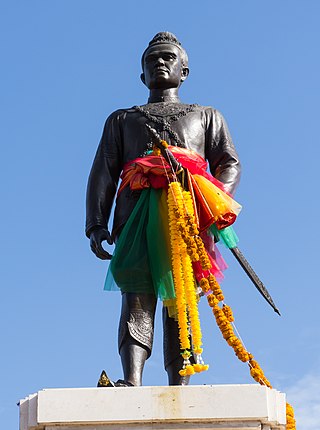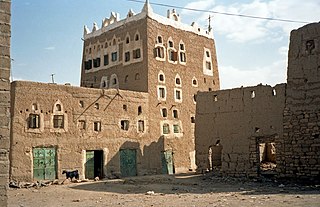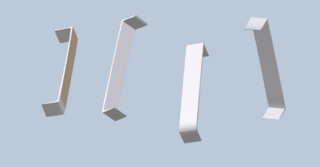Related Research Articles

King U-thong or KingRamathibodi I was the first king of the kingdom Ayutthaya, reigning from 1351 to 1369.

Wiman Joseon was a dynasty of Gojoseon. It began with Wiman's seizure of the throne from Gija Joseon's King Jun and ended with the death of King Ugeo who was a grandson of Wiman. Apart from archaeological data, the main source on this historical period comes from chapter 115 of Sima Qian's Records of the Grand Historian. Wiman was originally a Chinese military leader from the Kingdom of Yan under the Han dynasty.

The Twelfth Dynasty of ancient Egypt is a series of rulers reigning from 1991–1802 BC, at what is often considered to be the apex of the Middle Kingdom. The dynasty periodically expanded its territory from the Nile delta and valley South beyond the second cataract and East into Canaan.

The Gorkha Kingdom was a member of the Chaubisi rajya, a confederation of 24 states, located at the intersection of Himalayas and the Indian subcontinent. In 1743 CE, the kingdom began a campaign of military expansion, annexing several neighbors and becoming present-day Nepal. The Gorkha Kingdom extended to the Marshyangdi River in the west, forming its border with the Kingdom of Lamjung. To the east, the kingdom extended to the Trishuli River, forming its border with the Nepal Mandala. The Gorkha Kingdom was established in 1559 CE by Prince Dravya Shah, the second son of King Yasho Brahma Shah of Lamjung. The prince replaced the King Mansingh Khadka Magar who previously ruled the region.

Khutawyre Wegaf was a pharaoh of the early Thirteenth Dynasty of Egypt in the late Middle Kingdom/Second Intermediate Period. He is known from several sources, including a stele and statues. In the Turin King List he is the first ruler of this dynasty with a reign of 2 regnal years.

The Shah dynasty, also known as the Shahs of Gorkha or the Royal House of Gorkha, was the ruling Chaubise Thakuri dynasty and the founder of the Gorkha Kingdom from 1559 to 1768 and later the unified Kingdom of Nepal from 1768 to 28 May 2008.

Saada, a city and ancient capital in the northwest of Yemen, is the capital and largest city of the governorate of the same name, and the seat of the eponymous district. The city is located in the mountains of Serat (Sarawat) at an altitude of about 1,800 meters. In 2004, it was the tenth-largest city in Yemen and had an estimated population of 51,870.

The Zemene Mesafint was a period in Ethiopian history between the mid-18th and mid-19th centuries when the country was ruled by a class of Oromo elite noblemen who replaced Habesha nobility in their courts, making the emperor merely a figurehead. For the most part, the regional lords were tightly related by marriage and constituted a stable ruling elite that prevailed until the mid-20th century. In short, during the Zemene Mesafint, the emperors from the Solomonic dynasty were reduced to little more than figureheads confined to the capital city of Gondar.

The Welayta, Wolayta or Wolaitta are an ethnic group and its former kingdom, located in southern Ethiopia. According to the most recent estimate (2017), the people of Wolayta numbered 5.83 million in Welayta Zone. The language of the Wolayta people, similarly called Wolaytta, belongs to the Omotic branch of the Afro-Asiatic language family. Despite their small population, Wolayta people have widely influenced national music, dance and cuisine in Ethiopia.
The provinces of Eritrea existed since pre-Axumite times and became administrative provinces from Eritrea's incorporation as a colony of Italy until the conversion of the provinces into administrative regions. Many of the provinces had their own local laws since the 13th century.

Wolayita or Wolaita is an administrative zone in Ethiopia. Wolayita is bordered on the south by Gamo Zone, on the west by the Omo River which separates it from Dawro, on the northwest by Kembata Zone and Tembaro Special Woreda, on the north by Hadiya, on the northeast by the Oromia Region, on the east by the Bilate River which separates it from Sidama Region, and on the south east by the Lake Abaya which separates it from Oromia Region. The administrative centre of Wolayita is Sodo. Other major towns are Areka, Boditi, Tebela, Bale Hawassa, Gesuba, Gununo, Bedessa and Dimtu.

The Ningthouja dynasty, also known as Mangang dynasty, comprises the descendants of the kings of Manipur. Ningthouja literally means progeny of King. It has 125 extended families. It was apparently founded by King Nongdā Lāiren Pākhangba in 33 CE.

Marchuwa was a currency used by the Kingdom of Wolaita. Marchuwa was a bundle of thin metal strips one cubit long, used as trading currency. Marchuwa was equal to 18 Maria Theresa Thalers or 0.50 US dollars.

Kingdom of Wolaita, also known as Wolaita Kingdom, was a kingdom dominated by Wolayta people in today's southern Ethiopia from 1251 until conquest of Ethiopian Empire in 1896.

Kawo Tona Gaga was the last and most powerful king of the Kingdom of Wolaita. Tona Gaga was the 17th Kawo, or king, of the Tigre dynasty, the last independent dynasty of the Wolayta people.
Motolomi Sato or Kawo Motolomi Sato was the founder and one of the most famous kings of the Kingdom of Wolaita. He ruled part of present day Ethiopia in the 12th century under the Damot Kingdom under Wolayta malla dynasty. Kawo Motolomi was an expansionist king of Wolaita. The son of king Sato, he was of the indigenous and heroic Wolaitta-Malla family and his family can still be found in Wolaita. The governmental center of the Wolaita during the Motolami era was at the summit of a gorgeous mountain known as Damota, which ultimately became the name of the kingdom. The force of cavalry and infantry besieged Kawo Motolomi's palace, known as Xaazza Garuwaa.
Ogato Sana, also known as Kawo Sana Ogato in the Wolaitta language, was one of the most renowned kings of the Tigre dynasty along with the Kingdom of Wolaita. King Ogato had acquired all of the regions, not only by battle, but also through deception and the employment of spys among the Gamo, Gofa, Kucha, and Kambata tribes. During his reign, the pre-colonial Wolaita kingdom's agricultural modernization effort included expanding acreage, installing irrigation canals, and improving cattle breeds in order to implement modern dairy farming. King Ogato Sana was 10th rulers of the Wolaita kingdom under the Tigre dynasty. King Ogato had erected his palace at top of the Damot hills, driven the Hadiya people out of the present-day Humbo and Abaya in the north, and captured other provinces. To protect himself from intruders, he erected a fortification around his castle on Damot hill, as well as a defense trench surrounding Sore Mashedo.
Dalbo is a town in South Ethiopia Regional State, Ethiopia within Wolayita Zone. Dalbo is located about 304 km away from Addis Ababa to the south through Butajira. And the town is located 11 km, North from Sodo, the capital of Wolayita Zone. The coordinate point of the town in map is 6°54′0″N 37°52′0″E with elevation of 2349 meters above the sea level.
Wolaita Tussa Sports Club, also known as Wolaita Tussa, is a professional football club based in Wolaita Sodo, Ethiopia. The club was founded in 1988 by known pop of catholic missioner Gino Benanti. After its formation the club was well known and popular in southern region. They were a member of the Ethiopian Football Federation and now participating in Ethiopia U-20 Premier league. But latter on after playing the first round Wolaita Zone Youth and Sport department declared that Wolaita Tussa would not continue the second round because of budget deficit.
References
- ↑ "THE COUNTRY OF THREE THOUSAND YEARS OF CIVILIZATION:WOLAITA OR ETHIOPIA?" (PDF). www.multidisciplinaryjournals.com.
- ↑ "Power consolidation and Modernization of Wolaita kingdom" (PDF). www.globalscientificjournal.com.